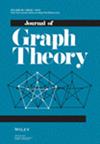求助PDF
{"title":"Kneser图子图的极大度","authors":"Peter Frankl, Andrey Kupavskii","doi":"10.1002/jgt.23213","DOIUrl":null,"url":null,"abstract":"<div>\n \n <p>In this paper, we study the maximum degree in nonempty-induced subgraphs of the Kneser graph <span></span><math>\n <semantics>\n <mrow>\n \n <mrow>\n <mi>KG</mi>\n \n <mrow>\n <mo>(</mo>\n \n <mi>n</mi>\n \n <mo>,</mo>\n \n <mi>k</mi>\n \n <mo>)</mo>\n </mrow>\n </mrow>\n </mrow>\n <annotation> <math xmlns=\"http://www.w3.org/1998/Math/MathML\" altimg=\"urn:x-wiley:03649024:media:jgt23213:jgt23213-math-0001\" wiley:location=\"equation/jgt23213-math-0001.png\"><mrow><mrow><mi>KG</mi><mrow><mo>(</mo><mi>n</mi><mo>,</mo><mi>k</mi><mo>)</mo></mrow></mrow></mrow></math></annotation>\n </semantics></math>. One of the main results asserts that, for <span></span><math>\n <semantics>\n <mrow>\n \n <mrow>\n <mi>k</mi>\n \n <mo>></mo>\n \n <msub>\n <mi>k</mi>\n \n <mn>0</mn>\n </msub>\n </mrow>\n </mrow>\n <annotation> <math xmlns=\"http://www.w3.org/1998/Math/MathML\" altimg=\"urn:x-wiley:03649024:media:jgt23213:jgt23213-math-0002\" wiley:location=\"equation/jgt23213-math-0002.png\"><mrow><mrow><mi>k</mi><mo>\\unicode{x0003E}</mo><msub><mi>k</mi><mn>0</mn></msub></mrow></mrow></math></annotation>\n </semantics></math> and <span></span><math>\n <semantics>\n <mrow>\n \n <mrow>\n <mi>n</mi>\n \n <mo>></mo>\n \n <mn>64</mn>\n \n <msup>\n <mi>k</mi>\n \n <mn>2</mn>\n </msup>\n </mrow>\n </mrow>\n <annotation> <math xmlns=\"http://www.w3.org/1998/Math/MathML\" altimg=\"urn:x-wiley:03649024:media:jgt23213:jgt23213-math-0003\" wiley:location=\"equation/jgt23213-math-0003.png\"><mrow><mrow><mi>n</mi><mo>\\unicode{x0003E}</mo><mn>64</mn><msup><mi>k</mi><mn>2</mn></msup></mrow></mrow></math></annotation>\n </semantics></math>, whenever a nonempty subgraph has <span></span><math>\n <semantics>\n <mrow>\n \n <mrow>\n <mi>m</mi>\n \n <mo>≥</mo>\n \n <mi>k</mi>\n \n <mfenced>\n <mfrac>\n <mrow>\n <mi>n</mi>\n \n <mo>−</mo>\n \n <mn>2</mn>\n </mrow>\n \n <mrow>\n <mi>k</mi>\n \n <mo>−</mo>\n \n <mn>2</mn>\n </mrow>\n </mfrac>\n </mfenced>\n </mrow>\n </mrow>\n <annotation> <math xmlns=\"http://www.w3.org/1998/Math/MathML\" altimg=\"urn:x-wiley:03649024:media:jgt23213:jgt23213-math-0004\" wiley:location=\"equation/jgt23213-math-0004.png\"><mrow><mrow><mi>m</mi><mo>\\unicode{x02265}</mo><mi>k</mi><mfenced close=\")\" open=\"(\"><mfrac linethickness=\"0\"><mrow><mi>n</mi><mo>\\unicode{x02212}</mo><mn>2</mn></mrow><mrow><mi>k</mi><mo>\\unicode{x02212}</mo><mn>2</mn></mrow></mfrac></mfenced></mrow></mrow></math></annotation>\n </semantics></math> vertices, its maximum degree is at least <span></span><math>\n <semantics>\n <mrow>\n \n <mrow>\n <mfrac>\n <mn>1</mn>\n \n <mn>2</mn>\n </mfrac>\n \n <mfenced>\n <mrow>\n <mn>1</mn>\n \n <mo>−</mo>\n \n <mfrac>\n <msup>\n <mi>k</mi>\n \n <mn>2</mn>\n </msup>\n \n <mi>n</mi>\n </mfrac>\n </mrow>\n </mfenced>\n \n <mi>m</mi>\n \n <mo>−</mo>\n \n <mfenced>\n <mfrac>\n <mrow>\n <mi>n</mi>\n \n <mo>−</mo>\n \n <mn>2</mn>\n </mrow>\n \n <mrow>\n <mi>k</mi>\n \n <mo>−</mo>\n \n <mn>2</mn>\n </mrow>\n </mfrac>\n </mfenced>\n \n <mo>≥</mo>\n \n <mn>0.49</mn>\n \n <mi>m</mi>\n </mrow>\n </mrow>\n <annotation> <math xmlns=\"http://www.w3.org/1998/Math/MathML\" altimg=\"urn:x-wiley:03649024:media:jgt23213:jgt23213-math-0005\" wiley:location=\"equation/jgt23213-math-0005.png\"><mrow><mrow><mfrac><mn>1</mn><mn>2</mn></mfrac><mfenced><mrow><mn>1</mn><mo>\\unicode{x02212}</mo><mfrac><msup><mi>k</mi><mn>2</mn></msup><mi>n</mi></mfrac></mrow></mfenced><mi>m</mi><mo>\\unicode{x02212}</mo><mfenced><mfrac linethickness=\"0\"><mrow><mi>n</mi><mo>\\unicode{x02212}</mo><mn>2</mn></mrow><mrow><mi>k</mi><mo>\\unicode{x02212}</mo><mn>2</mn></mrow></mfrac></mfenced><mo>\\unicode{x02265}</mo><mn>0.49</mn><mi>m</mi></mrow></mrow></math></annotation>\n </semantics></math>. This bound is essentially best possible. One of the intermediate steps is to obtain structural results on nonempty subgraphs with small maximum degree.</p>\n </div>","PeriodicalId":16014,"journal":{"name":"Journal of Graph Theory","volume":"109 1","pages":"88-96"},"PeriodicalIF":1.0000,"publicationDate":"2025-01-08","publicationTypes":"Journal Article","fieldsOfStudy":null,"isOpenAccess":false,"openAccessPdf":"","citationCount":"0","resultStr":"{\"title\":\"Maximal Degrees in Subgraphs of Kneser Graphs\",\"authors\":\"Peter Frankl, Andrey Kupavskii\",\"doi\":\"10.1002/jgt.23213\",\"DOIUrl\":null,\"url\":null,\"abstract\":\"<div>\\n \\n <p>In this paper, we study the maximum degree in nonempty-induced subgraphs of the Kneser graph <span></span><math>\\n <semantics>\\n <mrow>\\n \\n <mrow>\\n <mi>KG</mi>\\n \\n <mrow>\\n <mo>(</mo>\\n \\n <mi>n</mi>\\n \\n <mo>,</mo>\\n \\n <mi>k</mi>\\n \\n <mo>)</mo>\\n </mrow>\\n </mrow>\\n </mrow>\\n <annotation> <math xmlns=\\\"http://www.w3.org/1998/Math/MathML\\\" altimg=\\\"urn:x-wiley:03649024:media:jgt23213:jgt23213-math-0001\\\" wiley:location=\\\"equation/jgt23213-math-0001.png\\\"><mrow><mrow><mi>KG</mi><mrow><mo>(</mo><mi>n</mi><mo>,</mo><mi>k</mi><mo>)</mo></mrow></mrow></mrow></math></annotation>\\n </semantics></math>. One of the main results asserts that, for <span></span><math>\\n <semantics>\\n <mrow>\\n \\n <mrow>\\n <mi>k</mi>\\n \\n <mo>></mo>\\n \\n <msub>\\n <mi>k</mi>\\n \\n <mn>0</mn>\\n </msub>\\n </mrow>\\n </mrow>\\n <annotation> <math xmlns=\\\"http://www.w3.org/1998/Math/MathML\\\" altimg=\\\"urn:x-wiley:03649024:media:jgt23213:jgt23213-math-0002\\\" wiley:location=\\\"equation/jgt23213-math-0002.png\\\"><mrow><mrow><mi>k</mi><mo>\\\\unicode{x0003E}</mo><msub><mi>k</mi><mn>0</mn></msub></mrow></mrow></math></annotation>\\n </semantics></math> and <span></span><math>\\n <semantics>\\n <mrow>\\n \\n <mrow>\\n <mi>n</mi>\\n \\n <mo>></mo>\\n \\n <mn>64</mn>\\n \\n <msup>\\n <mi>k</mi>\\n \\n <mn>2</mn>\\n </msup>\\n </mrow>\\n </mrow>\\n <annotation> <math xmlns=\\\"http://www.w3.org/1998/Math/MathML\\\" altimg=\\\"urn:x-wiley:03649024:media:jgt23213:jgt23213-math-0003\\\" wiley:location=\\\"equation/jgt23213-math-0003.png\\\"><mrow><mrow><mi>n</mi><mo>\\\\unicode{x0003E}</mo><mn>64</mn><msup><mi>k</mi><mn>2</mn></msup></mrow></mrow></math></annotation>\\n </semantics></math>, whenever a nonempty subgraph has <span></span><math>\\n <semantics>\\n <mrow>\\n \\n <mrow>\\n <mi>m</mi>\\n \\n <mo>≥</mo>\\n \\n <mi>k</mi>\\n \\n <mfenced>\\n <mfrac>\\n <mrow>\\n <mi>n</mi>\\n \\n <mo>−</mo>\\n \\n <mn>2</mn>\\n </mrow>\\n \\n <mrow>\\n <mi>k</mi>\\n \\n <mo>−</mo>\\n \\n <mn>2</mn>\\n </mrow>\\n </mfrac>\\n </mfenced>\\n </mrow>\\n </mrow>\\n <annotation> <math xmlns=\\\"http://www.w3.org/1998/Math/MathML\\\" altimg=\\\"urn:x-wiley:03649024:media:jgt23213:jgt23213-math-0004\\\" wiley:location=\\\"equation/jgt23213-math-0004.png\\\"><mrow><mrow><mi>m</mi><mo>\\\\unicode{x02265}</mo><mi>k</mi><mfenced close=\\\")\\\" open=\\\"(\\\"><mfrac linethickness=\\\"0\\\"><mrow><mi>n</mi><mo>\\\\unicode{x02212}</mo><mn>2</mn></mrow><mrow><mi>k</mi><mo>\\\\unicode{x02212}</mo><mn>2</mn></mrow></mfrac></mfenced></mrow></mrow></math></annotation>\\n </semantics></math> vertices, its maximum degree is at least <span></span><math>\\n <semantics>\\n <mrow>\\n \\n <mrow>\\n <mfrac>\\n <mn>1</mn>\\n \\n <mn>2</mn>\\n </mfrac>\\n \\n <mfenced>\\n <mrow>\\n <mn>1</mn>\\n \\n <mo>−</mo>\\n \\n <mfrac>\\n <msup>\\n <mi>k</mi>\\n \\n <mn>2</mn>\\n </msup>\\n \\n <mi>n</mi>\\n </mfrac>\\n </mrow>\\n </mfenced>\\n \\n <mi>m</mi>\\n \\n <mo>−</mo>\\n \\n <mfenced>\\n <mfrac>\\n <mrow>\\n <mi>n</mi>\\n \\n <mo>−</mo>\\n \\n <mn>2</mn>\\n </mrow>\\n \\n <mrow>\\n <mi>k</mi>\\n \\n <mo>−</mo>\\n \\n <mn>2</mn>\\n </mrow>\\n </mfrac>\\n </mfenced>\\n \\n <mo>≥</mo>\\n \\n <mn>0.49</mn>\\n \\n <mi>m</mi>\\n </mrow>\\n </mrow>\\n <annotation> <math xmlns=\\\"http://www.w3.org/1998/Math/MathML\\\" altimg=\\\"urn:x-wiley:03649024:media:jgt23213:jgt23213-math-0005\\\" wiley:location=\\\"equation/jgt23213-math-0005.png\\\"><mrow><mrow><mfrac><mn>1</mn><mn>2</mn></mfrac><mfenced><mrow><mn>1</mn><mo>\\\\unicode{x02212}</mo><mfrac><msup><mi>k</mi><mn>2</mn></msup><mi>n</mi></mfrac></mrow></mfenced><mi>m</mi><mo>\\\\unicode{x02212}</mo><mfenced><mfrac linethickness=\\\"0\\\"><mrow><mi>n</mi><mo>\\\\unicode{x02212}</mo><mn>2</mn></mrow><mrow><mi>k</mi><mo>\\\\unicode{x02212}</mo><mn>2</mn></mrow></mfrac></mfenced><mo>\\\\unicode{x02265}</mo><mn>0.49</mn><mi>m</mi></mrow></mrow></math></annotation>\\n </semantics></math>. This bound is essentially best possible. One of the intermediate steps is to obtain structural results on nonempty subgraphs with small maximum degree.</p>\\n </div>\",\"PeriodicalId\":16014,\"journal\":{\"name\":\"Journal of Graph Theory\",\"volume\":\"109 1\",\"pages\":\"88-96\"},\"PeriodicalIF\":1.0000,\"publicationDate\":\"2025-01-08\",\"publicationTypes\":\"Journal Article\",\"fieldsOfStudy\":null,\"isOpenAccess\":false,\"openAccessPdf\":\"\",\"citationCount\":\"0\",\"resultStr\":null,\"platform\":\"Semanticscholar\",\"paperid\":null,\"PeriodicalName\":\"Journal of Graph Theory\",\"FirstCategoryId\":\"100\",\"ListUrlMain\":\"https://onlinelibrary.wiley.com/doi/10.1002/jgt.23213\",\"RegionNum\":3,\"RegionCategory\":\"数学\",\"ArticlePicture\":[],\"TitleCN\":null,\"AbstractTextCN\":null,\"PMCID\":null,\"EPubDate\":\"\",\"PubModel\":\"\",\"JCR\":\"Q2\",\"JCRName\":\"MATHEMATICS\",\"Score\":null,\"Total\":0}","platform":"Semanticscholar","paperid":null,"PeriodicalName":"Journal of Graph Theory","FirstCategoryId":"100","ListUrlMain":"https://onlinelibrary.wiley.com/doi/10.1002/jgt.23213","RegionNum":3,"RegionCategory":"数学","ArticlePicture":[],"TitleCN":null,"AbstractTextCN":null,"PMCID":null,"EPubDate":"","PubModel":"","JCR":"Q2","JCRName":"MATHEMATICS","Score":null,"Total":0}
引用次数: 0
引用
批量引用

 求助内容:
求助内容: 应助结果提醒方式:
应助结果提醒方式:


